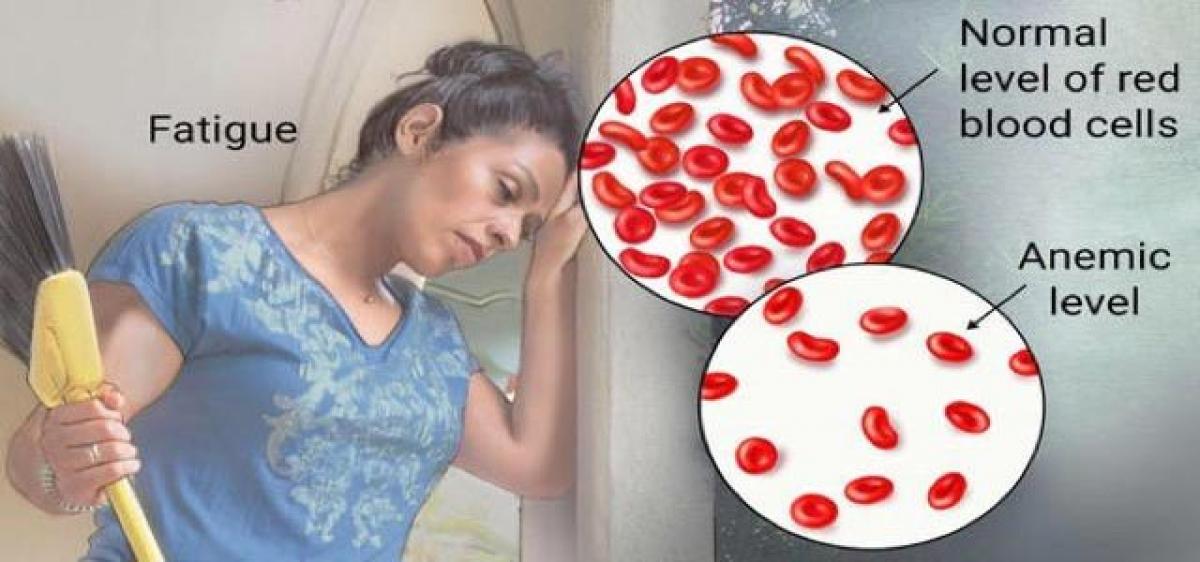Live
- New TTD Trust Board to meet in Tirumala today
- Drone survey held for laying smart roads
- MyVoice: Views of our readers 18th November 2024
- It’s time to defeat betrayers: Revanth in Maharashtra
- Committees formed, assigned tasks
- Let law and order be in sole domain of union!
- Group-III exams off to a smooth start
- KTR invited as guest of honour at TiEcon Kerala 2024
- KTR gets his freedom in a deal done in Delhi: Bandi Sanjay
- Hyderabad Ready to Host FIFA Friendly Football Match Between India and Malaysia
Just In

Anaemia, a blood disorder that is found across all the sections of the society affects both males and females. In Telangana, about 45 per cent women in the age group of 15-49 years in urban areas, and 55 per cent in the rural areas are anaemic.
Anaemia, a blood disorder that is found across all the sections of the society affects both males and females. In Telangana, about 45 per cent women in the age group of 15-49 years in urban areas, and 55 per cent in the rural areas are anaemic.
According to experts it is estimated that 80 per cent of children suffer from iron deficiency; pregnant women, too are at a higher risk and utmost care needs to be taken during the first trimester of pregnancy to ensure proper availability of iron.
In an interaction with The Local, Dr Balamba, leading gynaecologist who is associated with Shalini Hospital and former professor HOD - Obstetrics & Gynaecology, Osmania Medical College says that the reasons for the alarming rise in anaemia cases across the State is consumption of food without balanced nutrients. “People are not taking proper diet because the prices of vegetables are skyrocketing,” she opines.
Another reason is low awareness of the disorder and its implications, such as tiredness, low productivity which is commonly attributed to Chronic Fatigue Syndrome. The doctors says that children from private schools are accustomed to eating junk food that does not provide enough iron, proteins and carbohydrates to their body.
“The mid-day meal provided by the government to rural children is not enough to meet their nutritional needs. Low nutrition in children makes them anaemic and hence reduces the oxygen supply to the brain. This affects their concentration and grasping power and lowers their education level,” she adds.
Speaking about the age groups that are more susceptible to anaemia she says, “Children upto five years are at a higher risk since they are in the growth and development phase, adolescent girls are also prone to it because of heavy blood loss and maturing reproductive system as are mature women in child bearing age.”
“There are more anaemia cases reported from rural areas because of low awareness and inaccessibility especially in the tribal areas. As a result, the rate of maternal deaths is more compared to those in urban areas where medical facilities are available,” she says.
“There are many government programmes and initiatives on paper but, these are not implemented correctly and people are not aware of availing these initiatives. Evaluation of the performance of these programmes is also not done,” adds Dr Balamba.
The symptoms leading to anaemia, such as fatigue, disinterest in surroundings and low enthusiasm need to be investigated to check severity of the disease and should be treated accordingly.
“Mild anaemia can be treated with diet correction and increase in consumption of iron fortified foods and salts. Severe anaemia is treated medically after knowing the underlying cause. Iron supplements, injections and blood transfusions are used for treatment of severe anaemia,” concludes the doctor.
By Aneri Shah

© 2024 Hyderabad Media House Limited/The Hans India. All rights reserved. Powered by hocalwire.com







